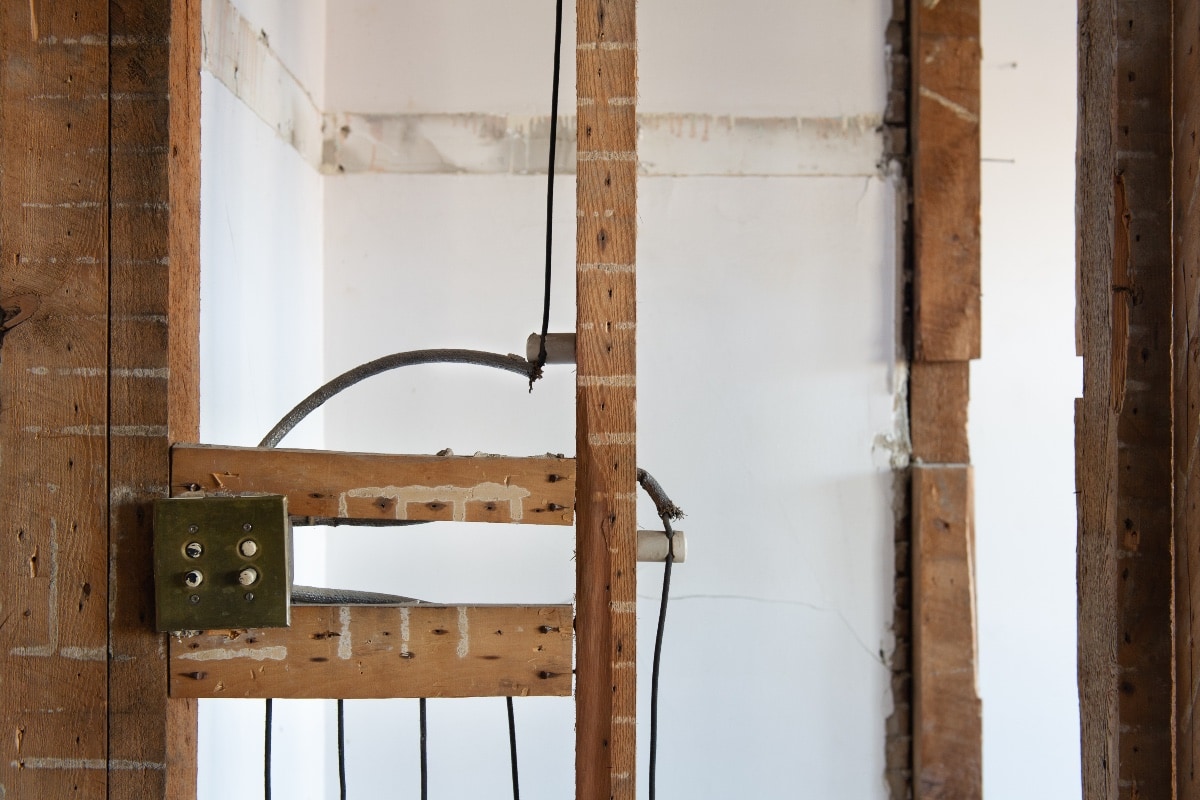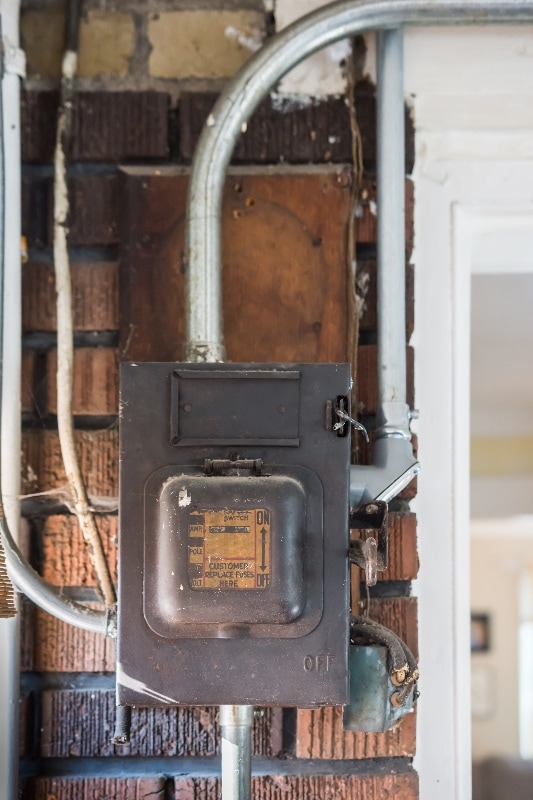Knob and tube wiring may be found throughout a house and can be recognized by a cotton cloth covering coated in rubber or asphalt. Live wires may get exposed because of the rubber coating breaking over time due to heat from the wires, which makes them brittle. We conducted research to find out how you can insulate around knob and tube wiring.
If the current knob and tube wiring is shielded by a box big enough to give the conductors three inches of clearance, then insulation is possible. However, as the system lacks a grounding conductor and therefore no built-in shock protection, this is not truly viable. Therefore, you should consult an electrician.
There is no protection against electric shock because the knob and tube lack a ground wire. Knob and tube wiring buried under insulation that has been improperly spliced or unmaintained are hazardous and challenging to detect. Please read on as we go over this subject.
![Electrical wires, Knob-and-tube, on a residential renovation site, How To Insulate Around Knob And Tube Wiring [And Is It Safe]](https://hvacseer.com/wp-content/uploads/2022/08/Electrical-wires-Knob-and-tube-on-a-residential-renovation-site-How-To-Insulate-Around-Knob-And-Tube-Wiring-And-Is-It-Safe-1.jpg)
Are Knob And Tube Wirings Safe?
There shouldn't be any fire safety problems if your home's knob and tube wiring were built and maintained correctly. But knob and tube wiring may be unsafe for several reasons.
Age
Over time, the rubberized material used to cover the wires may degrade and expose the wires. Certain circumstances can cause the copper wire to corrode from insulating additives. In addition, flammable or conductive building materials close by can come into contact with knobs and tubes, posing a major fire and electrical hazard.

A Tendency To Be Ignored
The knob and tube wiring's heat was intended to be freely released into the atmosphere. However, the knob and tube wirings are commonly covered with insulation due to home improvements that may have been carried out over the years.
There needs to be air space for the conductors of the knob and turn wiring to dissipate heat because they become warmer due to the circulation flowing through them.
Any insulation around the conductors' walls will retain this heat and increase the fire risk. Adding blown-in insulation makes it impossible for many homes with knob and turn wiring to gain energy efficiency.
Numerous Incorrect Modifications

Knob and tube wiring presents a greater chance for improper DIY changes because it is simple to reach for splicing. Rather than using electrical tape, amateurs typically use masking or Scotch tape for knob and tube wiring adjustments.
Even worse, inexperienced homeowners frequently overload circuits by installing fuses with amperage levels too high for knob and tube wiring, significantly raising the fire risk.
Moisture Compatibility Issues
The use of a knob and tube in damp conditions is not recommended. Because of this, using knobs and tubes outdoors or in wet locations like bathrooms, kitchens, laundry rooms, and utility rooms is extremely risky.
It Doesn’t Have Any Grounding
If the protective sheathing is destroyed or the electrical wiring is not grounded, you should replace it.
A bare copper ground wire connecting the circuit to the electrical panel is absent from the grounded wiring. Sheathing damage to electrical wiring may be repairable, but extensive damage may call for partial or complete wiring replacement.
All modern homes have a grounding system because a ground wire is necessary. Many older houses are not grounded. The electrical outlets in your home will instantly tell you if it is grounded.
How To Make Sure Your Knob And Tube Wiring Is Safe

Electricians frequently discard old wiring when rewiring homes. You should have an electrician examine your wiring if you suspect it to be knob-and-tube but are unsure of its condition.
To ensure the security of your knob and tube:
- Get a professional inspection
- Inspect for haphazard modifications
- Determine if it is active
- Add protection
If you think your home's wiring is made of knobs and tubes, make sure your family is protected by following the guidelines below.
Get A Qualified Inspector
Contact a licensed electrician to check your K&T system and recommend any further safety precautions. A certified electrician will verify the wiring, connections, receptacles, switches, and fuses or circuit breakers.
Check For Inadequate Modifications
Older properties are most frequently the victims of hasty electrical work performed by unlicensed electricians. This practice has become increasingly widespread as laws have changed and have made it more difficult for professionals to meet code.
Your knob and tube system needs to be checked for these random alterations.
Identify Whether It Is Active
If you discovered evidence of knob and tube wiring and are thinking about upgrading your electrical system or adding more insulation, the first thing you should do is call an electrician to check to see if the wiring is still in use.
Ask the electrician to also provide you with a price for the cost of replacing the wiring if they find that it is active. Depending on the contractor, these quotes are occasionally given for free.
Plan for the possibility that you won't have electricity while they replace the wiring after you've chosen a contractor and are trying to set a date for the job.
Hold the invoice until the job is finished. An insurance agency or insulation contractor must first confirm that the wiring is replaced.
Add Extra Safety
You can install ground fault protection (GFCI) to make your knob and tube wiring safer. Even if the GFCI is not grounded, it can detect excessive electrical flow and shut off power to the outlet, protecting users from electric shock.
Another thing you can install is arc fault protection (AFCI). House fires brought on by faulty knob and tube wiring connections can be avoided with an AFCI circuit breaker.
What Benefits Do Knob And Tube Wiring Offer?

Knob and tube wiring might have some benefits. Installing knob and tube wiring is less expensive than using another type. Knob and tube wiring, conduit, armored cable, and metal junction boxes are the options available to electricians.
The following are advantages to having a knob and tube wiring:
- The copper wire used is of a larger gauge
- Affordable installation
- Longevity
- Supports a home's basic electrical needs
- Heat dissipation
- Wires might be concealed and hidden
In addition to the porcelain standoffs, knob and tube wiring is frequently covered in cotton fabric and soft rubber insulation. The porcelain standoffs will keep bare wires safely insulated even though the real wire covering may have deteriorated over the years.
Copper Wire
The copper wire used in older knob and tube wiring is often of a wider gauge, or a bigger diameter, than electrical wiring used today. This is advantageous since bigger wires become cooler as electricity flows through them.
The wire can be left in place in older domestic electrical systems that don't show insulation degradation.
Affordable Installation
The materials and labor were less expensive compared to alternative options at the time. Over time, labor costs have climbed significantly. Knob and tube wiring is extremely labor-intensive to install, which is one reason why it lost popularity.
Longevity
Components made of porcelain are incredibly strong and have a long lifespan. A homeowner won't need to replace their wiring system anytime soon. Although durable, porcelain knobs act as insulators and stop wires from being over-tightened, extending their lifespan.
The ceramic tubes are strong and, if not damaged, can survive for many years. However, they would have some natural wear and tear over time, especially wiring and insulation. Animals like rats and other creatures can also try to nibble through the cables.
Electrical Needs Of Homes
Households do not have as many electrical types of equipment. But for lighting, knob and tube wirings work just fine. This is not the case for residences employing 150 to 200 amp electrical systems, let alone 60 amp electrical systems.
Heat Dissipation
The heat produced in the knob and tube wiring by the current loads up to 10 amps can be expelled, keeping the wires cool. It could sustain a larger amp capacity compared to other wiring styles available at the time.
Concealing The Wires
It is simple to put cables under floors, inside wall linings, or ceilings where they aren't accessible or won't cause harm.
In Closing
When insulating knob and tube wiring, it is important to consult a qualified electrician. It is unsafe and, as a precaution, you shouldn't change the knob and tube wiring. If you have knob and tube wiring in your home, have a professional assess it first.
If you find this informative, check out these articles too:
